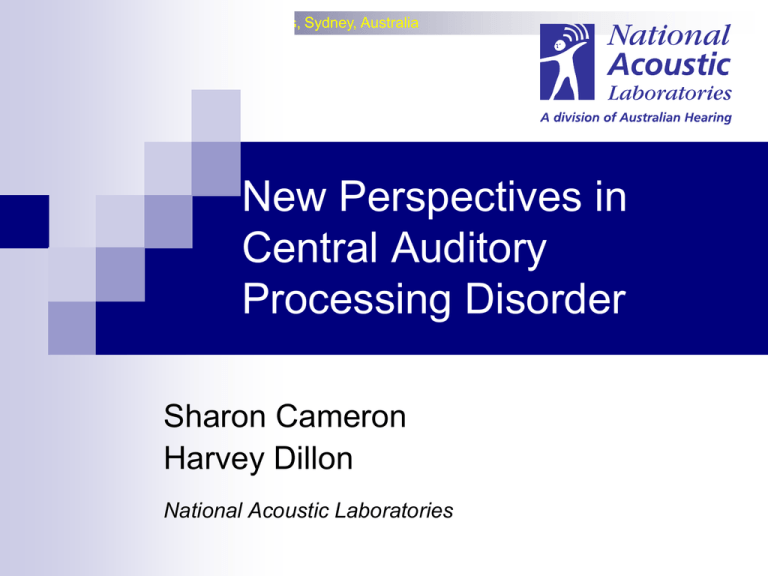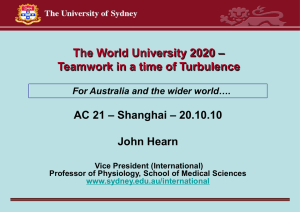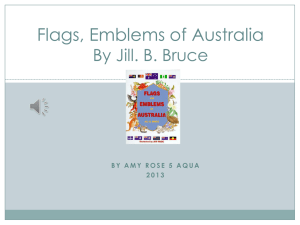Advanced Educational Audiology Lecture
advertisement

National Acoustic Laboratories, Sydney, Australia New Perspectives in Central Auditory Processing Disorder Sharon Cameron Harvey Dillon National Acoustic Laboratories National Acoustic Laboratories, Sydney, Australia OVERVIEW OF PRESENTATION 1. New perspectives on CAPD 2. Description of the LiSN-S 3. Research behind LiSN-S 4. LiSN-S and the traditional APD test battery 5. How to interpret LiSN-S results 6. Management options 7. Description of LiSN & Learn Auditory Training Software 8. LiSN & Learn Phase I and Phase II Clinicial Trial Results 9. LiSN Screening Test – Sensitivity and Specificity Study 10. LiSN-S “Prescribed Gain Amplifier” - HI Study 6-60+ Years 11. Question time National Acoustic Laboratories, Sydney, Australia What is CAPD? For children with (C)APD….. “….. internal distortions degrade the auditory signal so that top-down processing typically predominates in most listening situations, particularly those in which complex linguistic and cognitive demands are coupled with background noise” Putter-Katz et al (2002) National Acoustic Laboratories, Sydney, Australia Operations Required for Comprehension of Speech in Noise Wingfield, A and Tun, P (2007). J Am Acad Audiol 18:548–558 National Acoustic Laboratories, Sydney, Australia Source Discrimination aka Auditory Stream Segregation 5 1. The ability of the brain to tease apart all the sounds that arrive simultaneously at the ears and to form meaningful representations of the incoming acoustic information 2. Auditory cues such as the location of the sound, or the pitch of a speaker’s voice, help us to segregating the total stream of sound into its original sources National Acoustic Laboratories, Sydney, Australia LiSN-S Development LiSN-S was developed specifically to assess how children use: Spatial location cues (ITD, IID) Pitch differences between voices to separate target auditory stimuli from distracting auditory stimuli that arrive simultaneously at the ears National Acoustic Laboratories, Sydney, Australia LiSN-S Research – Spatial Processing Disorder Noise Noise Speech Noise Noise 7 National Acoustic Laboratories, Sydney, Australia Description 1. Adaptive speech-in-noise-test 2. Target sentences - 0º azimuth initially at 62dB SPL 3. Competing speech - 0º or ±90º azimuth at 55dB SPL 4. 3-D auditory environment under headphones 5. Offers alternative to free-field testing 6. No special hardware required 7. Four LiSN-S conditions National Acoustic Laboratories, Sydney, Australia LISN-S Conditions Low Cue SRT - SV0º DV0° Talker Advantage Spatial Advantage SV 90° High Cue SRT – DV90º ° 9 National Acoustic Laboratories, Sydney, Australia LiSN-S SRT & Advantage Measures National Acoustic Laboratories, Sydney, Australia Client Screen National Acoustic Laboratories, Sydney, Australia Configure Language National Acoustic Laboratories, Sydney, Australia Client Session National Acoustic Laboratories, Sydney, Australia Diagnostic Screen National Acoustic Laboratories, Sydney, Australia Results Screen National Acoustic Laboratories, Sydney, Australia Explanation Screen National Acoustic Laboratories, Sydney, Australia Client Assessment Report National Acoustic Laboratories, Sydney, Australia NA LiSN-S Sentence Equivalence Study Pre-adjusted Sentences 1 0.9 Percent Correct 0.8 0.7 0.6 0.5 0.4 0.3 0.2 0.1 0 -3 -2 -1 0 1 Variation in dB from Estimated SRT 2 3 National Acoustic Laboratories, Sydney, Australia NA LiSN-S Sentence Equivalence Study Sentences Adjusted in dB for Equal Intelligibility 1 Percent Correct 0.9 0.8 0.7 0.6 0.5 0.4 0.3 0.2 0.1 0 -3 -2 -1 0 Variation in dB from Estimated SRT 1 2 3 National Acoustic Laboratories, Sydney, Australia Australian LiSN-S Normative Data 202 participants: 106 children - 6 yrs, 2 mths to 17 yrs, 7 mths 60 young adults - 18 yrs, 1 mth to 29 yrs, 10 mths 36 older adults – 31 yrs, 8 mths to 60 yrs, 7 mths English as a first language; no history of hearing disorders; no learning or attention disorders; normal pure tone audiogram and middle ear function. National Acoustic Laboratories, Sydney, Australia Low Cue SRT 4 3 2 Better 1 0 -1 Low Cue SRT vs Age Group -2 p < 0.000001 Low Cue SRT (dB) -3 -4 -5 -6 9 8 7 6 11 10 50-60 40-49 30-39 25-29 20-24 18-19 16-17 14-15 12-13 Age Group National Acoustic Laboratories, Sydney, Australia High Cue SRT -10 -11 -12 Better -13 -14 High Cue SRT vs. Age Group -15 p < 0.000001 -16 High Cue SRT (dB) -17 -18 -19 -20 9 8 7 6 11 10 50-60 40-49 30-39 25-29 20-24 18-19 16-17 14-15 12-13 Age Group National Acoustic Laboratories, Sydney, Australia Talker Advantage 10 9 Talker Advantage vs. Age Group 8 p < 0.000001 7 Better 6 5 4 2 1 0 9 8 7 6 11 10 Talker Advantage (dB) 3 50-60 40-49 30-39 25-29 20-24 18-19 16-17 14-15 12-13 Age Group National Acoustic Laboratories, Sydney, Australia Spatial Advantage 18 17 Spatial Advantage vs Age Group 16 p = 00005 15 Better 14 13 12 10 9 8 9 8 7 6 11 10 Spatial Advantage (dB) 11 50-60 40-49 30-39 25-29 20-24 18-19 16-17 14-15 12-13 Age Group National Acoustic Laboratories, Sydney, Australia Total Advantage 18 17 Total Advantage vs Age Group 16 p = 0.003 15 Better 14 13 12 10 9 8 9 8 7 6 Total Advantage (dB) 11 11 10 50-60 40-49 30-39 25-29 20-24 18-19 16-17 14-15 12-13 Age Group National Acoustic Laboratories, Sydney, Australia Conclusions LiSN-S SRT scores show that the ability to understand speech in noisy environments develops with age, is adult like by 14 years and starts to decline by 50 years of age. LiSN-S advantage measures show that ability to use spatial and pitch cues does not decline once adult-like performance is reached. The ability to use spatial cues matures well before the ability to use pitch cues and thus plays a greater role in how well children, in particular, are able to hear speech in noise. National Acoustic Laboratories, Sydney, Australia LiSN-S Cut-Off Scores • Level below which performance on a LiSN-S measure is considered outside normal limits. • Two and three-part regression equations fitted to account for improvement with age. • Low and High Cue SRT: • max (intercept + B-value * age, max (c, d + e * age) + (2 * SDs of the residuals from the age-corrected trend lines) Talker, Spatial and Total Advantage: min (intercept + B-value * age, c) – (2 * SDs of the residuals from the age-corrected trend lines) National Acoustic Laboratories, Sydney, Australia Cut-off Scores - Low Cue SRT 6 4 2 0 -2 -4 Low Cue SRT (dB) -6 -8 -10 -12 0 10 20 30 40 Age 50 60 70 National Acoustic Laboratories, Sydney, Australia Cut-off Scores - High Cue SRT -6 -8 -10 -12 -14 -16 High Cue SRT (dB) -18 -20 -22 -24 0 10 20 30 40 Age 50 60 70 National Acoustic Laboratories, Sydney, Australia Cut-off Scores – Talker Advantage 16 14 12 10 8 6 4 Talker Advantage (dB) 2 0 -2 0 10 20 30 40 Age 50 60 70 National Acoustic Laboratories, Sydney, Australia Cut-off Scores – Spatial Advantage 22 20 18 16 14 12 10 Spatial Advantage (dB) 8 6 4 0 10 20 30 40 Age 50 60 70 National Acoustic Laboratories, Sydney, Australia Cut-off Scores – Total Advantage 22 20 18 16 14 12 Total Advantage (dB) 10 8 6 4 0 10 20 30 40 Age 50 60 70 National Acoustic Laboratories, Sydney, Australia LiSN-S Test-Retest Reliability • 85 participants recruited from NA LiSN-S normative data studies. • Retested on LiSN-S between 1 and 4 months after initial testing (average 2 months, 2 weeks). • Mean test-retest difference ranged from 0.05 dB to 0.5 dB. • RM ANOVA revealed no significant difference between test and retest (p = 0.307 to 0.974, age categorical variable). • Correlation between test and retest significant for all measures (p = 0.006 to <0.00001; r ranged from 0.3 to 0.6) National Acoustic Laboratories, Sydney, Australia Spatial Advantage Current effect: F(12, 72)=.81714, p=.63220 16 15 14 13 12 11 10 9 Spatial Advantage (dB) 8 7 6 5 6 7 8 9 10 11 12 13 Age Group 14 15 16 17 Adult Test Retest National Acoustic Laboratories, Sydney, Australia NA LiSN-S Critical Difference Scores Correction Factor (Mean Test-Retest Difference) SD of the Mean TestRetest Difference 1.64 x SD Critical Difference (Including Correction) dB dB dB dB Low-Cue SRT -0.49 1.51 2.47 -3.0 High-Cue SRT -0.44 2.40 3.93 -4.4 Talker Advantage 0.31 2.46 4.03 4.3 Spatial Advantage -0.05 2.21 3.63 3.6 Total Advantage 0.06 2.35 3.85 3.9 Condition National Acoustic Laboratories, Sydney, Australia Australian LiSN-S APD Study Nine children aged 6 to 11 years experiencing listening difficulties in class relative to peers who had no learning or attention disorder (SusAPD group). Eleven children with confirmed learning or attention disorders (LD group). Assessed on LISN-S and results compared to 70 agematched controls. Assessed with a traditional (C)APD test battery National Acoustic Laboratories, Sydney, Australia LiSN-S vs. Traditional Battery (LD Group) LD Group 4 2 0 -2 -4 -6 -8 -10 Min-Max Total Adv Spatial Adv 25%-75% Talker Adv HC SNR LC SNR MLD RGDT DD (LE) DD (RE) -12 PPS (LE) Median PPS (RE) Deviation from Mean Normal Performance 6 Cameron & Dillon (2008) National Acoustic Laboratories, Sydney, Australia LiSN-S vs. Traditional Battery – SusAPD Group SusCAPD Group 4 2 0 -2 -4 -6 -8 -10 Total Adv Spatial Adv Talker Adv HC SNR LC SNR MLD RGDT DD (LE) Min-Max DD (RE) 25%-75% PPS (LE) Median -12 PPS (RE) Deviation from Mean Normal Performance 6 Cameron & Dillon (2008) National Acoustic Laboratories, Sydney, Australia Better Low Cue SRT (LD) National Acoustic Laboratories, Sydney, Australia Better Spatial Advantage National Acoustic Laboratories, Sydney, Australia LiSN-S Results – Normal Male, 11 years, 10 months showing Normal Performance National Acoustic Laboratories, Sydney, Australia LiSN-S Results - SPD Male, 7 years, 5 months with Spatial Processing Deficit National Acoustic Laboratories, Sydney, Australia LiSN-S Results – Memory Deficit Male, 8 years, 3 months with Memory Deficit National Acoustic Laboratories, Sydney, Australia LiSN-S Results – Attention Issues Female, 7 years, 10 months with Attention Issues National Acoustic Laboratories, Sydney, Australia Managing Spatial Hearing Deficits 1. Teacher-directed strategies 2. Child-directed strategies 3. Language training 4. Classroom modification (+10 dB SNR) 5. Assistive listening device 6. Training in source discrimination National Acoustic Laboratories, Sydney, Australia Auditory Training Research Develop deficit-specific remediation for children with a spatial processing deficit. Trains children to use binaural cues – i.e. differences in the timing and intensity of signals arriving at the ears from various locations to attend to a target stimulus and filter distracting auditory signals. Used in the home (as well as schools/clinics). Provides detailed analysis, reporting and feedback. Alternative/adjunct to ALD’s and other management strategies. National Acoustic Laboratories, Sydney, Australia Description of LISN & Learn Four games presented on PC over headphones Target sentences at 0º azimuth (initially 62 dB SPL) Competing stories at ±90º azimuth (55 dB SPL) Weighted up-down adaptive procedure used to adjust the signal level of the target SRT calculated over 40 sentences 131,220 unique sentences can be generated National Acoustic Laboratories, Sydney, Australia LISN & Learn Game Target at 0˚: The horse kicked six wet shoes Distracters at + and -90˚: Tamsin’s Blanket (-90˚) Eric’s Alarm Clock (+90˚) National Acoustic Laboratories, Sydney, Australia Target: The horse kicked six wet shoes National Acoustic Laboratories, Sydney, Australia Method 9 children (6 to 11 years) - LISN-S SA >2SD TOVA-A TAPS-3 memory sub-tests CAPD Pediatric SSQ LISN & Learn - 15 minutes per day; 5 days per week; over 12 weeks (120 games) Re-evaluate post-training; 3 months post-training National Acoustic Laboratories, Sydney, Australia LiSN & Learn SRT (dB) Better LiSN & Learn - Performance Over Time (n=9) 10 dB Game Number National Acoustic Laboratories, Sydney, Australia LiSN-S Results – Pre vs. Post (n=9) LiSN-S Score (Population Standard Deviation Units) 2 1 0 LC SRT - p = 0.158 Talker Advantage - p = 0.981 -1 HC SRT - p = 0.0002 Spatial Advantage - p = 0.0002 Total Advantage - -2 -3 Pre-Training Post-Training 3M Post-Training -4 LC SRT HC SRT Talker LiSN-S Condition Spatial Total p = 0.001 National Acoustic Laboratories, Sydney, Australia Additional Results – Pre- vs. Post Training CAPD SSQ: TOVA-A Listening in Quiet – p = 0.103 Listening in Noise – p = 0.0002 Omissions – p = 0.168 Commissions – p = 0.0004 TAPS-3 Memory Index – p = 0.003 National Acoustic Laboratories, Sydney, Australia Conclusion LiSN & Learn training has the potential to strengthen or reorganize connections dedicated to binaural processing. Training results in enhanced ability to process speech in background noise. National Acoustic Laboratories, Sydney, Australia Method – Phase II Clinical Study 1. 20 children - LISN-S spatial advantage >2SD from mean a) b) 2. 10 x LiSN & Learn (experimental group) 10 x Earobics (control group) Questionnaire a) b) c) Participant (LIFE) Parent (Fishers) Teacher (LIFE) 3. LiSN & Learn or Earobics training – 15 minutes per day 4. Re-evaluate LiSN-S and questionnaires post-training 5. Offer LiSN & Learn to control group. 56 National Acoustic Laboratories, Sydney, Australia Phase II Study - LiSN & Learn Group (n=1) 2 1.5 SD from Mean 1 0.5 0 -0.5 -1 -1.5 -2 -2.5 -3 -3.5 Low Cue SRT High Cue SRT Pre-training Post-training Talker Adv Spatial Adv Total Adv National Acoustic Laboratories, Sydney, Australia Phase II Study - Earobics Group (n=1) 2 1.5 SD from Mean 1 0.5 0 -0.5 -1 -1.5 -2 -2.5 -3 -3.5 Low Cue SRT High Cue SRT Pre-training Post-training Talker Adv Spatial Adv Total Adv National Acoustic Laboratories, Sydney, Australia LiSN-S Screening Test Develop screening test to be used by teachers, speech pathologist, psychologists. Fully-automated instructional, testing, scoring and reporting functions. Accessible via internet. End-users own computer and headphones used. Aims to: Decrease time taken to refer children (and adults) with suspected CAPD for diagnostic testing with LiSN-S. Reduce inappropriate referrals. Reduced referral time will result in speedier implementation of management and remediation programs for those with SPD. National Acoustic Laboratories, Sydney, Australia LiSN Screening Test Client data 1. End-user inputs client data Sound check 1. Sets output level of computer soundcard 2. Reference tone consists of “pulsed” speech-shaped broadband noise 3. Reference tone is presented at 40 dB below level of combined distracters 4. Listener adjusts volume control until he or she can “just hear” the reference tone 5. Assumed to be at least 10 dB SPL 6. Therefore level of distracters presented during test is approx 50 dB SPL National Acoustic Laboratories, Sydney, Australia LiSN Screening Test Word familiarization task (in quiet) 1. 3 target words (red, blue, green) 2. 12 “foils” (e.g. hat, doll, milk) 3. Listener clicks on picture that matches word until all words correctly identified. LiSN Screening Test 1. Distracters – looped stories (DV +/- 90º) 2. Targets and foils: • • • Female 1 at 0º initially presented at SNR of +4 dB 2 second ISI 4. Listener clicks mouse when target heard. 5. Adaptive procedure used to find SRT that yields 50% intelligibility. 6. Level of word stimuli adjusted in 3 dB steps. 7. At least 6 targets presented as practice. 8. SRT calculated over up to 40 scored targets National Acoustic Laboratories, Sydney, Australia LiSN-S Screening Test Studies 1. 2. Target Stimulus Equalization Study a) 30 adults aged 18 to 29 years b) SRT of scored target words (red, blue, green) consolidated across participants and psychometric functions formulated c) Amplitude of target words adjusted for equal intelligibility Sensitivity and Specificity Study a) 40 children and adults with suspected CAPD b) Tested with LiSN Screening Test at referring centre c) Tested with LiSN-S no more than 3 weeks later at NAL d) Correlation between LiSN Screening Test and LiSN-S determined e) ROC analysis used to determine sensitivity and specificity f) Optimum criteria cut-off scores determined National Acoustic Laboratories, Sydney, Australia LiSN-S Prescribed Gain Amplifier National Acoustic Laboratories, Sydney, Australia CAPD and Hearing Impairment Studies 1. LiSN-S Study a) b) c) 160 participants (40 x 6-17; 20 x 18-29; 20 x 30-59; 80 x 60+) Confirmed mild-to-moderately-severe SNHL (3FAHL of 65 dB) Assessment gools: • • • • 2. LiSN-S + PGA LIFE Questionnaire (6-17 years) SSQ Questionnaire (18-60+ years) COGNISTAT (60+ years) “LiSN & Learn” Study a) b) c) 60 participants (10 x 6-17; 10 x 18-60; 10 x 60+) Confirmed mild-to-moderately-severe SNHL (3FAHL of 65 dB) Assessment tools: • • • • d) LiSN-S + PGA Memory Test LIFE Questionnaire (6-17 years) SSQ Questionnaire (18-60+ years) “LiSN & Learn” + PGA (120 games) then re-assess National Acoustic Laboratories, Sydney, Australia References Brown, D., Cameron, S. Martin, J., Watson, C., & Dillon, H. (in press). The North American Listening in Spatialized Noise – Sentences Test (NA LiSN-S): Normative data and test-retest reliability studies for adolescents and young adults. Cameron ,S., Brown, D., Keith, R., Martin, J., Watson, C., & Dillon, H. (2009). Development of the North American Listening in Spatialized Noise - Sentences Test (NA LISN-S): Sentence equivalence, normative data and test-retest reliability studies. Journal of the American Academy of Audiology, 20(2), 128-146. Cameron, S. & Dillon H. (2009) Listening in Spatialized Noise – Sentences test (LISN-S) (Version 1.013) [Computer software]. Murten, Switzerland: Phonak Communications AG. Cameron, S. & Dillon, H. (2008). The Listening in Spatialized Noise – Sentences Test: Comparison to prototype LISN test and results from children with either a suspected (central) auditory processing disorder of a confirmed language disorder. Journal of the American Academy of Audiology, 19(5), 377391. Cameron, S. & Dillon, H. (2008). Spatial hearing deficits as a major cause of auditory processing disorders: Diagnosis with the LISN-S and management options. In R. Seewald & J. Bamford, eds. A Sound Foundation Through Early Amplification 2007. Proceedings of the Fourth International Conference: Phonak AG, Switzerland, 235-241. Cameron, S. & Dillon, H. (2007). Development of the Listening in Spatialized Noise - Sentences Test (LISN-S). Ear and Hearing, 28(2), 196-211. Cameron, S. & Dillon, H. (2007). The Listening in Spatialized Noise - Sentences Test (LISN-S): Testretest reliability study. International Journal of Audiology, 46, 145-153. National Acoustic Laboratories, Sydney, Australia Acknowledgements and Q&A Dr Harvey Dillon Director of Research National Acoustic Laboratories Helen Glyde Research Audiologist National Acoustic Laboratories







